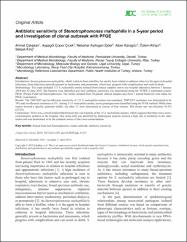| dc.contributor.author | Çalışkan, Ahmet | |
| dc.contributor.author | Çiçek, Ayşegül Çopur | |
| dc.contributor.author | Ejder, Nebahat Aydoğan | |
| dc.contributor.author | Karagöz, Alper | |
| dc.contributor.author | Kirişçi, Özlem | |
| dc.contributor.author | Kılıç, Selçuk | |
| dc.date.accessioned | 2020-12-19T19:36:54Z | |
| dc.date.available | 2020-12-19T19:36:54Z | |
| dc.date.issued | 2019 | |
| dc.identifier.citation | Çalışkan, A., Çopur Çicek, A., Aydogan Ejder, N., Karagöz, A., Kirişci, Ö., & Kılıç, S. (2019). Antibiotic sensitivity of Stenotrophomonas maltophilia in a 5-year period and investigation of clonal outbreak with PFGE. Journal of infection in developing countries, 13(7), 634–639. https://doi.org/10.3855/jidc.11171 | en_US |
| dc.identifier.issn | 1972-2680 | |
| dc.identifier.uri | https://doi.org/10.3855/jidc.11171 | |
| dc.identifier.uri | https://hdl.handle.net/11436/1490 | |
| dc.description | WOS: 000487585400007 | en_US |
| dc.description.abstract | Introduction: Stenotrophomonas maltophilia, which is able to form a biofilm, has mostly been related to catheters when it is the agent in hospital infections; these infections generally present as bacteremia and pneumonia, which may progress with complications and result in death. Methodology: the study included 153 S. maltophilia strains isolated from clinical samples sent to our hospital laboratory between 1 January 2014 and 30 June 2018. the bacteria were identified and their antibiotic sensitivity was determined using the VITEK-2 automated system. PFGE (Pulsed Field Gel Electrophoresis): the strains isolated from 34 patient clinical samples and from 1 patient bedcover were taken for PFGE examination. Results: the TMP/SXT and levofloxacin sensitivity of 153 S. maltophilia strains was examined. TMP/SXT resistance was determined to be 39% and levofloxacin resistance at 5%. Among 35 S. maltophilia strains, seven genotypes were identified using the PFGE method. While three strains showed a specific genotype profile, the other 32 were determined to consist of four clusters. the cluster rate was therefore 91.4% (32/35). Conclusions: There was a clonal relationship between the vast majority of the 35 S. maltophilia isolates, which suggests that there was a cross-contamination problem in the hospital. One strain (#4) was identified by dendrogram analysis showed a high rate of similarity to the other strains and was determined to be the common source of the cross-contamination. | en_US |
| dc.language.iso | eng | en_US |
| dc.publisher | J Infection Developing Countries | en_US |
| dc.rights | info:eu-repo/semantics/openAccess | en_US |
| dc.subject | Pulsed field gel electrophoresis | en_US |
| dc.subject | Clonal outbreak | en_US |
| dc.subject | Sntibiotic sensitivity | en_US |
| dc.title | Antibiotic sensitivity of Stenotrophomonas maltophilia in a 5-year period and investigation of clonal outbreak with PFGE | en_US |
| dc.type | article | en_US |
| dc.contributor.department | RTEÜ, Tıp Fakültesi, Temel Tıp Bilimleri Bölümü | en_US |
| dc.contributor.institutionauthor | Çiçek, Ayşegül Çopur | |
| dc.identifier.doi | 10.3855/jidc.11171 | |
| dc.identifier.volume | 13 | en_US |
| dc.identifier.issue | 7 | en_US |
| dc.identifier.startpage | 634 | en_US |
| dc.identifier.endpage | 639 | en_US |
| dc.ri.edit | oa | en_US |
| dc.relation.journal | Journal of Infection in Developing Countries | en_US |
| dc.relation.publicationcategory | Makale - Uluslararası Hakemli Dergi - Kurum Öğretim Elemanı | en_US |


















